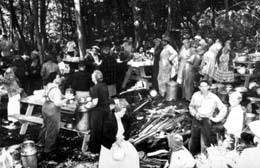On July 27, 1949, more than 500 Stanwood and Camano Island residents participate in a unique community effort to build a park in one day. The effort, organized by the South Camano Grange, results in creation of Camano Island State Park, the first state park on the island.
South Camano Grange
In 1949 Camano Island was -- as it still is -- a rural island accessible by bridge from Stanwood in Snohomish County. It had 1,150 people living on it, according to the 1950 U.S. Census and is part of Island County along with Whidbey Island.
The local Grange was established in 1930 and was noted for its annual clam dinners, dances, and for providing youth activities with the Scouts and 4-H at their community hall. At the time the South Camano Grange recognized the community improvement needs that were not being met by the local government on Whidbey Island, two hours away by car.
They entered a National Grange Community Service Contest as part of an effort to rally the community to secure road-improvement funds; select a suitable garbage dump; build a community playground; provide cemetery cleanup; tuberculosis-testing services; repair and painting of the Lutheran Church, Mabana schoolhouse and Utsalady Ladies Aid; and petition for revaluation of property. But by far the most impressive accomplishment was the organization of 500 volunteers to build a new state park in one day in July 1949.
Building the Park
In its description of the project, the Grange said, "Our entire shoreline was owned by individuals, resorts, or real estate or lumber companies, except ninety feet in three different points owned by the County, these not generally known. The general public had no access to the beach" -- yet they lived on an island!
The Grange petitioned the Washington State Parks Commission and the State set aside 92 acres of school land at Point Lowell for a park. The Parks Commission agreed to contribute $5,000 toward the purchase of the park if the community would demonstrate its commitment by providing volunteers to help construct the park. The South Camano Grange agreed to follow through and organize the project. Mayors of nearby Stanwood and East Stanwood cooperated by proclaiming a State Park Day and merchants promised to close for a day and bring their employees to work on the project.
Three bulldozers, nine farm tractors with equipment, 34 pickups and trucks, one large trailer truck, three wreckers, and a team of horses worked all day. The women served their traditional clam chowder, coffee, sandwiches, cookies, pop, and ice cream for the volunteers. A doctor and nurse, with emergency supplies in a hospital tent, were on duty along with the State Fire Warden.
By the day's end, the volunteers had built picnic tables, cleared land and paths, and leveled a road and parking area. They had provided a place for everyone to get to the beach. All labor -- 3,561 man-hours and 376 machine hours -- and all expenses had been donated. The estimated value of the work was $6,000. The South Camano Grange won third prize in the national contest.
Volunteer Efforts Continue
In 1958, Camano Island State Park expanded with the acquisition of an additional Point Lowell tract. The State Parks Commission voted to extend the original park around the point to Elger Bay, an additional 3,000 feet of waterfront. Today (2012) the park covers 134 acres, with 6,700 feet of shoreline, and has 88 campsites and five cabins, among other amenities.
In 1992 the community petitioned and volunteered thousands of hours to acquire another 430 acres on Camano as a second state park, the Cama Beach State Park. Thanks to the generosity of the original landowners, sisters Karen Risk Hamalainen and Sandra Risk Worthington, the property that was once the popular Cama Beach Resort has been preserved as a state park. And thanks to community support, the park has a mile of shoreline, mature second growth forest, many of its original historic buildings preserved and a dynamic and proactive group of staff and volunteers to make the most of it.

